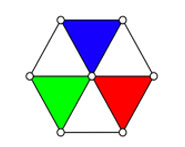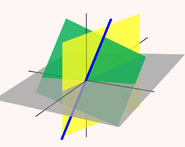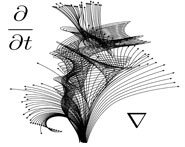


 تاريخ الرياضيات
تاريخ الرياضيات
 الرياضيات في الحضارات المختلفة
الرياضيات في الحضارات المختلفة 
 الرياضيات المتقطعة
الرياضيات المتقطعة
 الجبر
الجبر
 الهندسة
الهندسة 
 المعادلات التفاضلية و التكاملية
المعادلات التفاضلية و التكاملية 
 التحليل
التحليل
 علماء الرياضيات
علماء الرياضيات |
Read More
Date: 28-7-2016
Date: 1-5-2022
Date: 8-3-2022
|
A Hamilton decomposition (also called a Hamiltonian decomposition; Bosák 1990, p. 123) of a Hamiltonian regular graph is a partition of its edge set into Hamiltonian cycles. The figure above illustrates the six distinct Hamilton decompositions of the pentatope graph 
The definition is sometimes extended to a decomposition into Hamiltonian cycles for a regular graph of even degree or into Hamiltonian cycles and a single perfect matching for a regular graph of odd degree (Alspach 2010), with a decomposition of the latter type being known as a quasi-Hamilton decomposition (Bosák 1990, p. 123).
For a cubic graph, a Hamilton decomposition is equivalent to a single Hamiltonian cycle. For a quartic graph, a Hamilton decomposition is equivalent to a Hamiltonian cycle 




In the 1890s, Walecki showed that complete graphs 


In 1954, Ringel showed that the hypercube graph 



Laskar and Auerbach (1976) showed that the complete bipartite graph 










Alspach et al. (2012) showed that Paley graphs admit Hamilton decompositions.
Kotzig (1964) showed that a cubic graph is Hamiltonian iff its line graph has a Hamilton decomposition (Bryant and Dean 2014).
It is not too difficult to find regular Hamiltonian non-vertex transitive graphs that are not Hamilton decomposable, as illustrated in the examples above.
It is more difficult to characterize regular Hamiltonian vertex-transitive graphs that are not Hamilton decomposable. S. Wagon (pers. comm., Feb. 2013; Dupuis and Wagon 2014) had conjectured that all connected vertex-transitive graphs are Hamilton decomposable with the following exceptions: 















However, the conjecture was refuted by Bryant and Dean (2014), who showed that there are infinitely many connected vertex-transitive graphs that have no Hamilton decomposition, including infinitely many of vertex degree 6, and including Cayley graphs of arbitrarily large vertex degree. The counterexamples arise from a generalization of the triangle-replaced graph to 













Alspach, B.; Bermond, J.-C.; and Sotteau, D. "Decomposition Into Cycles. I. Hamilton Decompositions." In Proceedings of the NATO Advanced Research Workshop on Cycles and Rays: Basic Structures in Finite and Infinite Graphs held in Montreal, Quebec, May 3-9, 1987 (Ed. G. Hahn, G. Sabidussi, and R. E. Woodrow). Dordrecht, Holland: Kluwer, pp. 9-18, 1990.
Alspach, B. "The Wonderful Walecki Construction." Bull. Inst. Combin. Appl. 52, 7-20, 2008.
Alspach, B. "Three Hamilton Decomposition Problems." University of Western Australia. May 11, 2010.
http://symomega.files.wordpress.com/2010/05/talk8.pdf.Alspach, B.; Bryant, D.; and Dyer, D. "Paley Graphs Have Hamilton Decompositions." Disc. Math. 312, 113-118, 2012.
Bosák, J. Decompositions of Graphs. New York: Springer, 1990.
Bryant, D. E. "Cycle Decompositions of Complete Graphs." In Surveys in Combinatorics 2007 (Eds. A. J. W. Hilton and J. M. Talbot). Cambridge, England: Cambridge University Press, 2007.
Bryant, D. and Dean, M. "Vertex-Transitive Graphs that have no Hamilton Decomposition." 25 Aug 2014.
http://arxiv.org/abs/1408.5211.Dupuis, M. and Wagon, S. "Laceable Knights." To appear in Ars Math Contemp.Gould, R. J. "Advances on the Hamiltonian Problem-A Survey." Graphs Combin. 19, 7-52, 2003.
Kotzig, A. "Hamilton Graphs and Hamilton Circuits." In Theory of Graphs and Its Applications (Proc. Sympos. Smolenice). Praha: Nakl. CSAV, pp. 63-82, 1964.
Laskar, R. and Auerbach, B. "On Decomposition of 



|
|
|
|
دخلت غرفة فنسيت ماذا تريد من داخلها.. خبير يفسر الحالة
|
|
|
|
|
|
|
ثورة طبية.. ابتكار أصغر جهاز لتنظيم ضربات القلب في العالم
|
|
|
|
|
|
|
سماحة السيد الصافي يؤكد ضرورة تعريف المجتمعات بأهمية مبادئ أهل البيت (عليهم السلام) في إيجاد حلول للمشاكل الاجتماعية
|
|
|